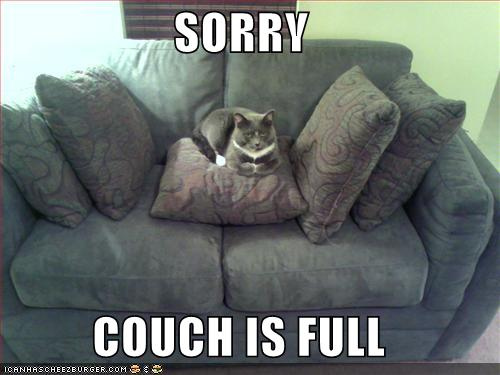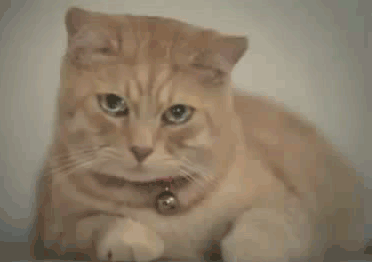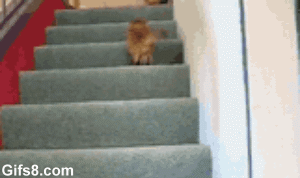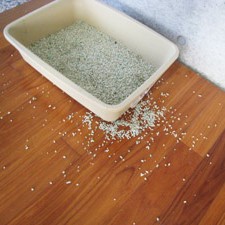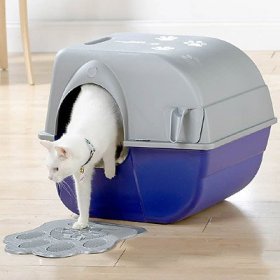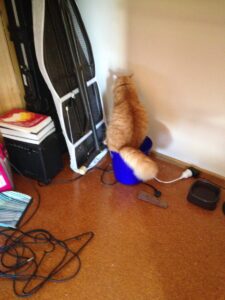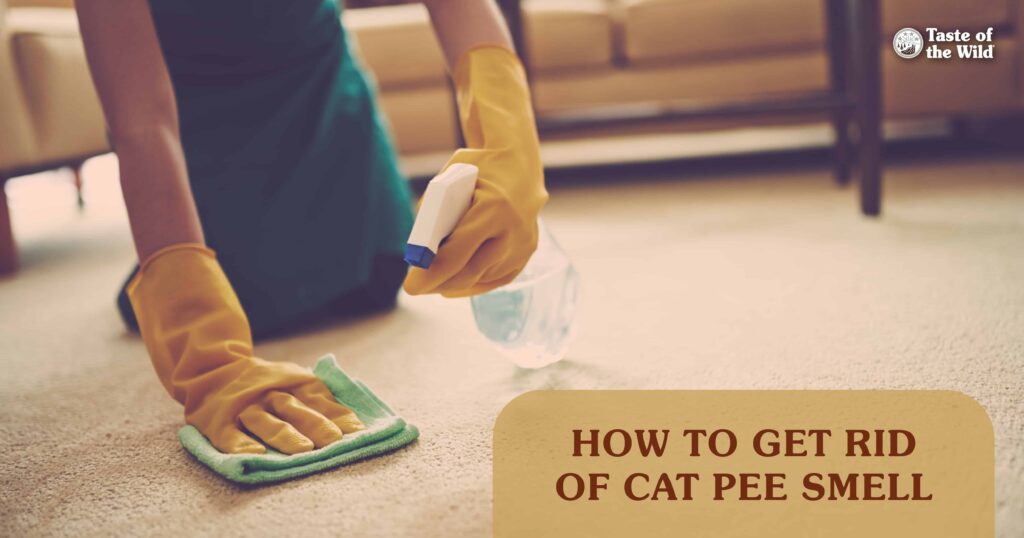
It’s an eye-watering smell that’s instantly recognizable — cat pee. Litter typically does a great job at deodorizing cat pee, so when you smell it in your house, you know something’s not right. And so the hunt for the source of the stench begins. Behind the couch? The laundry basket? Under the bed — or worse, on the bed?
In situations like this, it’s good to be prepared and have the supplies you need to remove cat urine odor and stains as quickly as possible. The sooner you clean cat urine up, the easier it is to eliminate that lingering cat pee odor. To help you know what to do when a urine cat-astrophe inevitably happens, we’ve got some cat pee cleaning tips and some advice on how to prevent urinary accidents in the first place. So bookmark this page for future reference!
Why Does Cat Pee Stink So Bad?
Although cat pee has a very strong and distinctive smell, normal cat urine is actually about 95 percent water. The tell-tale acidic smell of cat pee comes from urea, uric acid, creatinine and ammonia, which are the natural waste products of broken-down protein in the urine. If you notice a strong ammonia smell coming from the litter box, that’s caused by urea in the pee being broken down into ammonia by bacteria in the environment. If you smell ammonia coming from the litter box, that’s a good sign that the litter needs your attention.
Even More Reasons for That Cat Urine Smell
Cat urine generally smells worse than dog urine because it’s more concentrated and it contains felinine. Found only in the urine of domestic cats and their close relatives (e.g., bobcats and lynx), felinine is a sulfur-containing amino acid that is actually odorless. But it breaks down into highly volatile and stinky compounds. Unneutered male cats (tom cats) typically have smellier urine due to testosterone and higher amounts of felinine in their pee.
If You Smell It, Clean It
If your cat has had an “accident,” don’t wait to clean it. Dried urine stains are harder to remove and the smell will become stronger the longer the cat urine is left there. As well as removing the smell so you can breathe fresh air again, quickly removing the urine stain and odor helps ensure your cat doesn’t use the same spot again next time. If they (or another cat in your home) can smell cat urine, they’ll likely keep using it as their new place to pee.
What Not to Do to Get Rid of Cat Urine Odor and Stains
We’re going to go over a few “don’ts” first. Don’t scrub or rub the urine — you’ll just make it soak in even further. Don’t use a steam cleaner by itself because the heat can make the cat urine stains and smells even worse. Don’t use any ammonia-based products because your cat may be attracted by the ammonia smell and pee in the same area again. Don’t punish your cat. There is typically a reason a cat pees outside their box, and you need to work out what that is (more on that later).
How to Clean Up Cat Urine
The Ohio State University Indoor Pet Initiative has some useful tips on cleaning urine off different surfaces. The supplies you should keep on hand include white vinegar, paper towels, club soda and possibly an enzyme cleaner. Here is a summary of their cat urine cleaning tips plus recommendations from the Sleep Foundation on removing cat urine from a mattress.
How to Get the Cat Pee Smell Out of Clothes
Machine wash your laundry using a cup of white vinegar and no detergent. Once the cycle is done, repeat the wash using regular detergent.
How to Get the Cat Pee Smell Out of Carpet
Use a towel or paper towels to blot up as much of the urine as you can. Cover the area with paper towels or a towel and stand on them — do this several times. Saturate the area with carpet cleaner or a few drops of dish detergent mixed with water and let it sit for an hour or two. Rinse the spot by gently blotting and using a wet sponge with water to rinse again. Soak the area with club soda for 10 minutes then blot up the club soda and put a pile of paper towels on the spot again with something heavy on top overnight. The next morning, spray the area with an enzyme cleaner. If your cat continues to use the area, you may need to replace the padding underneath the carpet.
How to Clean Cat Pee Off Linoleum or Hardwood
For linoleum, use paper towels or a mop soaked in soapy water to wipe up the pee. Rinse the area with warm water and then wipe with a sponge moistened with white vinegar and let the floor air dry. For hardwood floors, blot the urine then use an enzyme cleaner. If the smell remains, you may need to sand, bleach and refinish the hardwood floor.
How to Get Cat Pee Smell Out of a Mattress
If your cat pees on your mattress, the Sleep Foundation recommends blotting with paper towels or a towel to soak up as much liquid as possible. Mix a solution of half water and half distilled vinegar in a spray bottle, spray the area and then blot again. Cover the area with a generous layer of baking soda and let it sit on the mattress for as long as possible (at least 8 hours). Vacuum off the baking soda and repeat the vinegar and baking soda process until the odor and stains are gone. They recommend using an enzyme cleaner if the vinegar and baking soda don’t work.
Why Do Cats Pee Outside Their Litter Box?
If your cat is urinating everywhere but their kitty litter box, you should investigate why. It could be a health issue, a dirty litter box, behavioral issues or territorial marking. The quicker you address the problem, the easier it will be to get your cat using the correct place again.
Health conditions like bladder stones and crystals, bacterial urinary tract infections and feline idiopathic cystitis cause pain and an increased urgency to go. Your cat may associate their litter box with this pain so they urinate elsewhere. If your cat is urinating more than usual due to some other health reason, your litter box cleaning schedule may not be keeping up with the amount of urine as they’re producing and they won’t use it.
A change of lifestyle, routine or diet can cause stress which may cause urinary accidents. A perception of a threat to your cat’s territory like an outdoor cat in the yard or new pets or people in your home can trigger urine spraying.
If you have an older cat, arthritis may be making it harder to get into the litter box, so make sure you get one with low sides. Older cats can also suffer cognitive dysfunction (like dementia in people) and forget where the box is.
Cats Like a Clean Litter Box
To keep litter boxes inviting places to use, it’s recommended that you scoop the litter daily, change all of the litter weekly and do a deep clean every few weeks. A general rule is to have one litter box per cat plus an extra one. It should be placed in a quiet, private area that’s away from their food.
It’s an unpleasant task, but make sure you’re paying attention to what’s going on in the box to watch out for health issues. Does the urine smell worse, are there larger or smaller amounts of urine, has the frequency of using the box changed?
Accidents happen, but regular inappropriate urination isn’t normal. If you notice any changes in your cat’s urinary habits, contact your veterinarian so they can check if your cat is healthy and help get your cat peeing in the correct place again.





